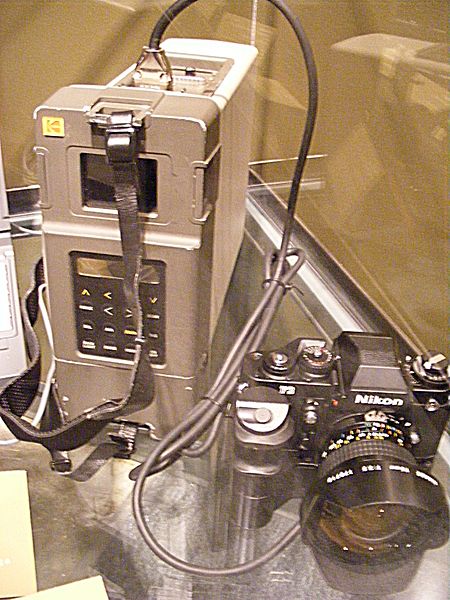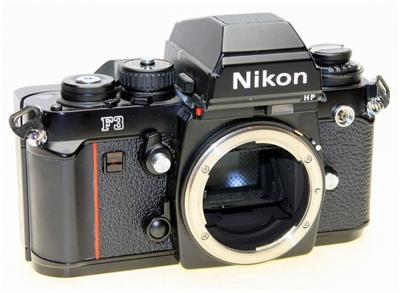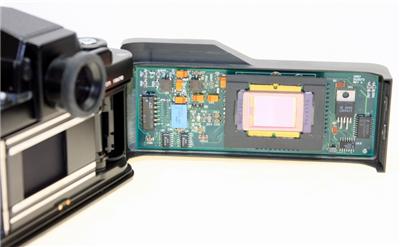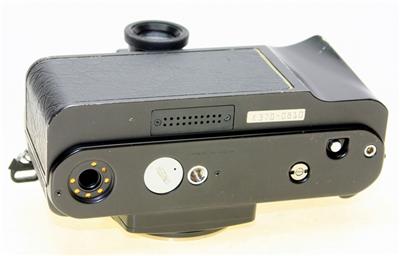This is probably the most interesting Nikon patent since I started my coverage in 2008: last year Nikon filed a patent (2012-242615) in Japan for a digital back that will transform a 35mm film SLR camera into a DSLR. The sensor is attached to the camera’s back panel and by replacing it, you will be able to get the digital solution many have dreamed for years (digital FM2 anyone?). Since the back panel is detachable, the switch between film and digital SLR will be simple and fast. The patent application is current – it was filed on May 19, 2011 and was published a week ago (December 10, 2012). In the patent Nikon describes a mechanism for adjusting/fine-tuning the flange distance with a screw located on the digital back. Here are few paragraphs from the actual patent application I copied directly from the Japanese IPDL database (machine translated):
The camera back exchange type camera which images the object image acquired by the photographing optical system by the side of a camera body, and obtains electronic image data is known by replacing with the rear lid with which the camera body was equipped, and equipping a camera body with the camera back having an image sensor.
In the camera back of the description to this Patent document 1, when the moving mechanism to which the position of an image sensor is moved, and the position detection sensor which detects the position of an image sensor are provided and a moving mechanism moves an image sensor based on the output of a position detection sensor, The image sensor to the photographing optical system by the side of a camera body is positioned.
Fig.4 is a rear elevation of the film camera which illustrates the state where the rear lid 7 was opened wide. In Fig.4, the rear lid 7 is constituted centering on the hinge 17, enabling free rotation. The pressure plate 8 is provided inside the rear lid 7. The pressure plate 8 is processed so that the surface may be provided with high flatness and slidability. The rear lid key 16 is engaged where the rear lid key 13 and the rear lid 7 which were provided at the cartridge chamber 12 side of the camera body 2 are closed.
Fig.5 is a figure which illustrates the electronic camera back 101 by this embodiment. The rear lid 7 illustrated to Fig.2 and Fig.3 is replaced with and equipped with the electronic camera back 101.In Fig.5, the hinge 17 and the rear lid key 16 are the same as the hinge 17 and the rear lid key 16 which were provided by the rear lid 7. Unlike the pressure plate 8 in the rear lid 7, in the electronic camera back 101, the image sensor retainer board 102 holding the image sensor 103 is arranged by the camera back main part 101a. The image sensor 103 is fixed to the image sensor retainer board 102. If the camera body 2 is equipped with the electronic camera back 101 and engagement of the rear lid key 13 and the rear lid key 16 by the side of the camera body 2 is carried out, the image sensor 103 will oppose with the opening 11.
Fig.6 is the cross sectional view which cut the electronic camera back 101 by this embodiment with the section A-A shown in Fig.5.The image sensor chip 103a is installed in the inside of the image sensor 103. The image sensor chip 103a converts the image imaged with the taking lens 1 (Fig.2) in the imaging surface 103b to electric picture information, and the conversion is performed only in the rectangular range of a predetermined size. The glass plate 103c for protecting the image sensor chip 103a is provided by the image sensor 103.
Fig.7 is the cross sectional view which cut the electronic camera back 101 by this embodiment with section B-B shown in Fig.5.The left lateral of the positioning protruding part 102a functions as the X positioning part 102c as mentioned above. The X lever 117 is provided so that the end 117a may project to the camera body 2 side through the hole 102e of the image sensor retainer board 102, and it is supported pivotally with an axis parallel to Y-direction by the axis 117b pivotable to the image sensor retainer board 102. The X lever 117 stands, it has the bending part 117c, and levorotation power is given by the torsion spring 118. However, by the protruding part 117d of the X lever 117 abutting the left part of the hole 102e of the image sensor retainer board 102, the X lever 117 has the levorotation restricted and is held at the position to which the protruding part 117d abuts the left part of the hole 102e.
Fig.8 shows the cross sectional view cut in the state where the electronic camera back 101 was closed in this way in the same section (section A-A shown in Fig.5) as Fig.6.If the electronic camera back 101 is closed, the point of the Z-direction adjusting screw 104 will abut the inner rail 10a of the camera body 2, and the point of the Z-direction adjusting screws 105 and 106 will abut the inner rail 10b of the camera body 2, respectively. About the Z-direction adjusting screw 105, it did not illustrate in the convenience above figure 8 of a section.
Fig.9 shows the cross sectional view cut in the same section (section B-B shown in Fig.5) as Fig.7 in the state where the electronic camera back 101 was closed to the camera body 2.If the electronic camera back 101 is closed, the X positioning part 102c and the end 117a of the X lever 117 will enter into the opening 11 of the camera body 2. The size of the X positioning part 102c and the X lever 117 is beforehand decided so that the X positioning part 102c and the end 117a of the X lever 117 may not bar a motion of a shutter curtain at this time.
Over 20 years ago, Kodak had a similar digital back solution with the Kodak Professional Digital Camera System (DCS 100) which was the first commercially available DSLR camera:
Here is a closer look of the Kodak DCS100 mounted on a Nikon F3 camera:
Via Egami















